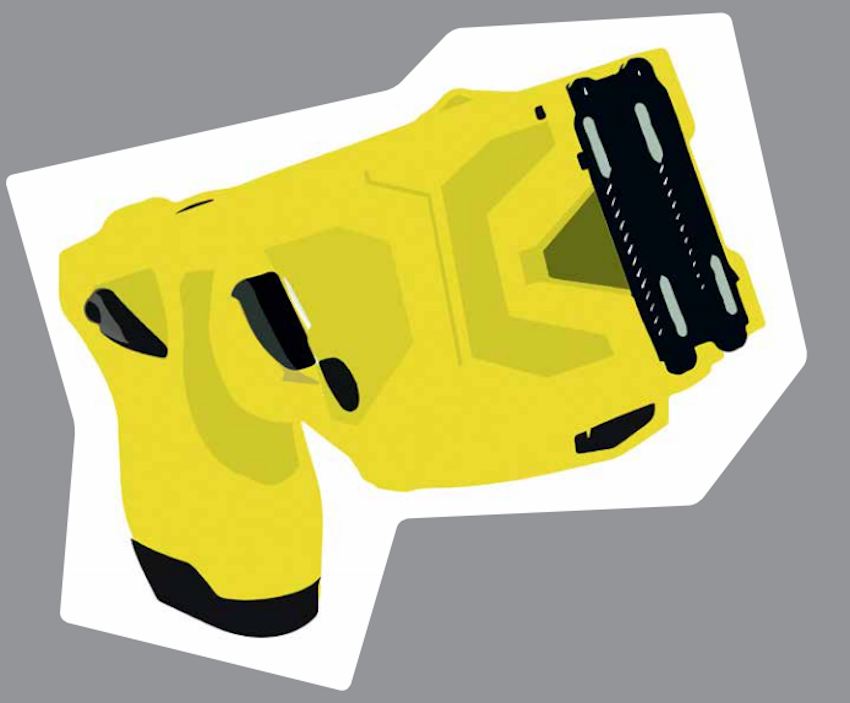In a year’s time, the German Ministry of the Interior could decide on the nationwide equipment of the Federal Police with electroshock weapons. Until then, the officers may in a pilot project shoot at children as well.
At the beginning of September, the Federal Police Inspectorates Berlin-Ostbahnhof, Kaiserslautern and Frankfurt/Main-Hauptbahnhof started a pilot project on the use of tasers. But the officers are to avoid shots at heart patients. This is stated in an administrative regulation of 7 August, which the Federal Ministry of the Interior has only just published in the governmental “Ministerialblatt” for the “Taser X2” model of the US manufacturer Axon. The document can only be obtained for a fee; the FOIA platform “Frag den Staat” has put it online.
With tasers, the officers shoot tiny arrows connected to a wire, which penetrate the skin by about one centimetre and emit a current pulse of 50,000 volts for several seconds. Those affected feel a very strong pain and are initially completely paralysed.
“Aids for physical violence”
Up to now, only the special unit GSG 9 of the Federal Police was equipped with tasers, but according to a report in the “Spiegel” they were never used there. In the GSG 9, the devices are treated as firearms, whereas in the new pilot project of the Federal Police they are no longer considered “weapons” but “aids for physical violence”. Their application is regulated in §2 paragraph 3 of the Act on Direct Coercion in the Exercise of Official Force by Federal Enforcement Officers (UzwG). Comparable means there are handcuffs, water cannons, police dogs or horses. However, as with firearms, the “electro-pulse devices” are stored in the responsible police station, so that they cannot be used off-duty.
The Federal Police intend to use their approximately 30 tasers in situations where other measures “are not suitable or disproportionate with regard to a safe handling of the situation”. This is intended to avoid or at least minimise any danger to police officers. The second objective is to prevent the use of “more serious means of intervention” such as firearms.
The criminologist and police scientist Thomas Feltes takes a critical view of this: “Anyone who is hit by a taser falls down like a tree – videos on this can be found on the Internet. In which direction the person falls and where he or she hits their head is not predictable, serious injuries are pre-programmed,” writes the long-standing holder of the Chair of Criminology, Criminal Policy and Police Science of the Faculty of Law at the Ruhr University Bochum when being asked for this article.
Direct shock remains prohibited
Human rights organisations also criticise the use of tasers as extremely risky and often fatal. Amnesty International counts several hundred deaths in the USA alone. The German section is therefore against their deployment. Also in some German states, people have already died during the use of tasers. There, too, the electro-pulse weapons are being tested in pilot projects, including by special units such as the Bavarian USK, but also by patrol officers in Hesse and Rhineland-Palatinate.
According to an Amnesty study on taser in the Netherlands, operations there are often inadmissible or disproportionate, including their use against handcuffed prisoners or detainees. There are no provisions on this in the administrative regulation of the German Federal Police. However, the so-called “contact mode” is prohibited, in which the device is held directly against the body and causes severe pain but no paralysis.
How are risk groups identified?
According to the now published regulation, the German officers have to threaten the use of the taser beforehand. They should then fire the stun gun “if possible against the back” or on the lower torso of the target person. The simultaneous use of two devices against one person is not allowed.
In addition to heart patients, use against pregnant women should also be avoided. The administrative regulation does not determine how the officers assess the two risk groups as described “according to the external impression”. “Even trained cardiologists cannot recognise cardiac patients by their appearance. How are police officers supposed to do that in a stressful situation,” criticises police scientist Feltes. Further details could be regulated in a directive for the Federal Police, which, however, is not published.
Shooting at people who are in danger of falling down or who are in the water should also be avoided. In situations which could cause a “disproportionate risk”, such as people in the water, operating machines or carrying a child in their arms, officers should resort to other means. Children themselves, on the other hand, may be shot, but only in self-defence or emergency aid.
Defibrillators for “risk minimisation”
The Federal Police is well aware of the lethal effect of an “electro-pulse device” on the circulation of those affected, according to the answer to a parliamentary question. Before the pilot project, the Federal Ministry of the Interior ordered a scientific study at the Austrian Institute for Health Care Engineering. The Technical University in Graz is a “European test centre for medical devices”. The result of the study states that the residual risk for those affected is “small, but in principle not completely negligible”.
In order to “minimise the risk”, the police officers involved in the pilot project should therefore carry defibrillators for the emergency treatment of cardiac arrhythmias and be trained in their use.
The use of “Taser X2” must be documented in accordance with the administrative regulation vis-à-vis the Federal Ministry of the Interior, indicating “special incidents”. After completion of the one-year trial, the Federal Police intend to consider a nationwide roll-out in the regular police service.
Image: Study from Amnesty International about the Dutch use of tasers.





Leave a Reply